This vanilla bean cake is super moist, full of vanilla flavor, is rich and buttery, made from scratch and covered in buttercream. It’s the best vanilla cake I’ve ever had and I have a feeling it will quickly become your family’s favorite.
When it comes to cake, there is nothing more comforting than a vanilla cake. It’s a classic for a reason. It’s not overpowering in flavor and is perfect for weddings and birthdays.
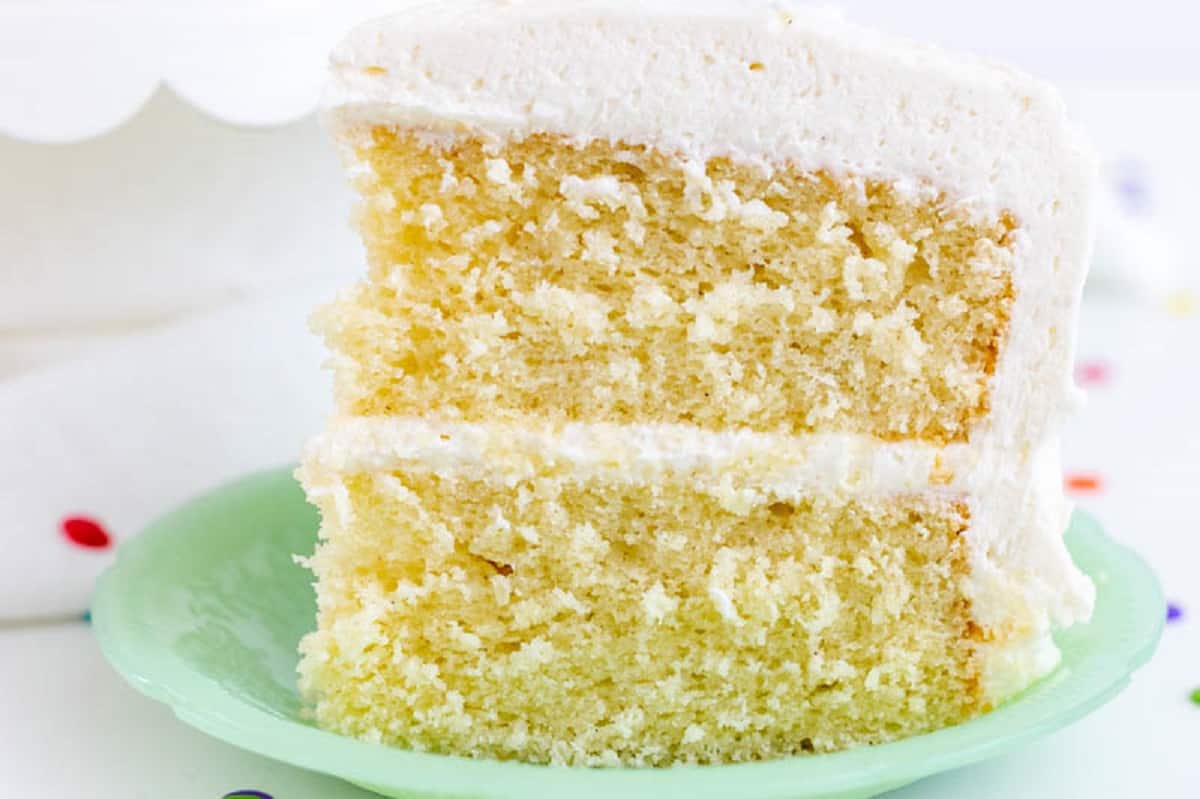
Hey there! Before you scroll, there’s lot’s of important stuff in the post!…including the FAQ section, which may answer any questions you might have about this recipe. Enjoy!
The good news is that you don’t need a box mix to make a good vanilla cake. This cake is super moist, with just the right amount of sweetness without being too heavy or dense like some scratch cakes can be.
Plus it’s actually pretty easy to make. In my opinion, it’s the absolute best vanilla cake recipe and you won’t want to stop eating it.
I’ve also included a video lower in the post on how to make this layer cake from scratch so that you can follow along step-by-step.
Ingredient Notes:
Now let’s talk a little about just some of the ingredients that are in this vanilla bean cake. (The printable list of all ingredients are in the recipe card below.)
(Make sure to check out the FAQ section below in this post for substitution questions.)
Cake flour: This recipe calls for cake flour instead of all-purpose flour. Using cake flour will give your cake a softer texture. If you can’t get cake flour, make sure to check out the FAQ section lower in this post for a substitute.
Unsalted butter: Butter gives this cake a really nice flavor. It also gives a lot of moisture to the cake.
Sour cream: I love using sour cream in cakes. It really adds to the flavor and gives it a ton of moisture.
Vanilla bean paste: This is the real flavor star of this recipe. Although you can still use vanilla extract, using vanilla bean paste gives it even more flavor. It’s just so good and I urge you to just try it.
Here are a couple of vanilla bean pastes to try:
Sometimes, vanilla pean paste can get a little expensive though, so just know that you can use vanilla extract and it’ll still taste amazing.
Almond baking emulsion: This ingredient is optional, but I think it’s really the secret ingredient to this cake.
Now, just hear me out on the almond emulsion. The recipe only calls for a very small amount and it does NOT taste like ordinary almond extract, which I personally don’t even like.
No, this recipe calls for almond baking emulsion, not almond extract. To me, they taste WAY different.
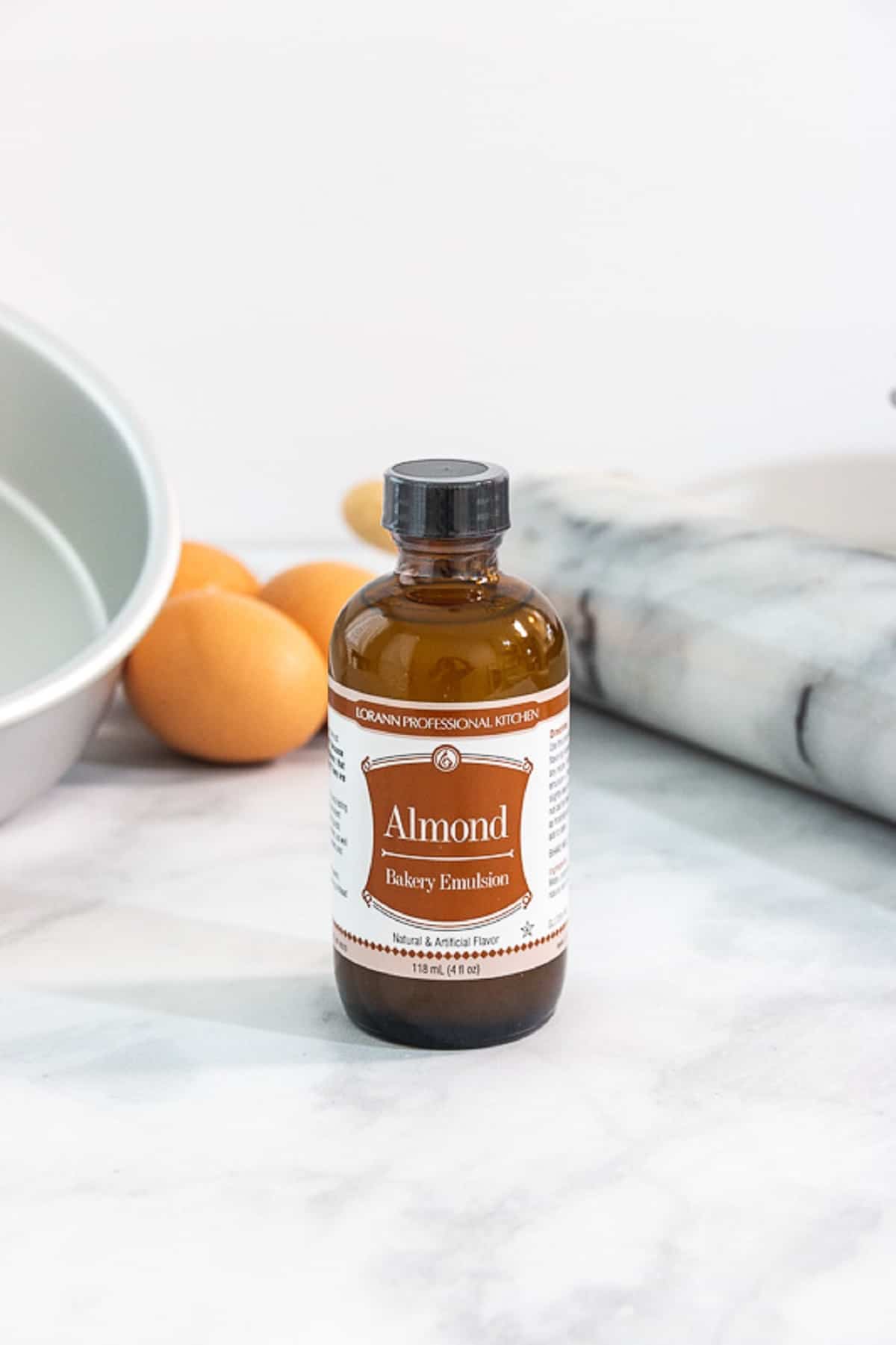
Even if you think you won’t like anything with almond extract in it…I have one question for you…have you tried it? Sometimes things taste totally different than you expect. I mean I don’t even like almonds, but I like this because to me…it doesn’t taste like almonds.
Here’s my point on the almond emulsion: This recipe only calls for half a teaspoon. That isn’t much and it’s not strong or overpowering at all. All it does is help bring out the flavor of the vanilla bean paste.
When you taste this cake, you don’t really taste an almond flavor. You just know it’s got this full vanilla bean flavor and something a little special that makes you never want to stop eating it.
I’ve personally been told loads of times by people that they don’t what’s in the cake, but they just couldn’t stop eating it.
As always though…if you are allergic to almonds, then don’t use it. If you’ve already tried it and you don’t like it…it’s ok! I won’t be mad at you and you can still make this cake with just vanilla bean paste or extract and it will STILL be awesome.
Vanilla bean buttercream: You’re gonna want to add buttercream to this cake and I have just the one for you. You can find that recipe here: Vanilla Bean Buttercream
How to Make this Cake:
Let’s talk a little about how to make this vanilla bean cake. (The printable instructions are in the recipe card below.)
Step 1:
First, you’ll need to preheat the oven to 350 degrees F. (Now, just know that you’re going to turn the oven temp down to 325 degrees F once you put the cakes in the oven.)
The thought process behind this is to give the cake a boost of heat to help it rise higher, but then to let the temp go lower so that it doesn’t over-brown the bottom and top.
You’ll also want to go ahead and grease and flour two 8-inch round cake pans that are about 2 inches high. (If making cupcakes, make sure and read the notes in the recipe post or the FAQ section lower in this post.)
Step 2:
Now combine the flour, sugar, baking powder, baking soda and salt in a mixing bowl and whisk.
Step 3:
In another bowl, combine the sour cream, milk, oil, vanilla, almond and eggs. Mix well with a whisk and set aside.
Step 4:
Now cut the butter into chunks. Then, turn the mixer on low and add the butter slowly to your dry ingredients. You’ll just mix on low to medium until all the butter is added, then switch to medium, medium-high and mix until all the flour is coated with the butter and the mixture is crumbly.
You want the mixture to resemble a sand-like texture.
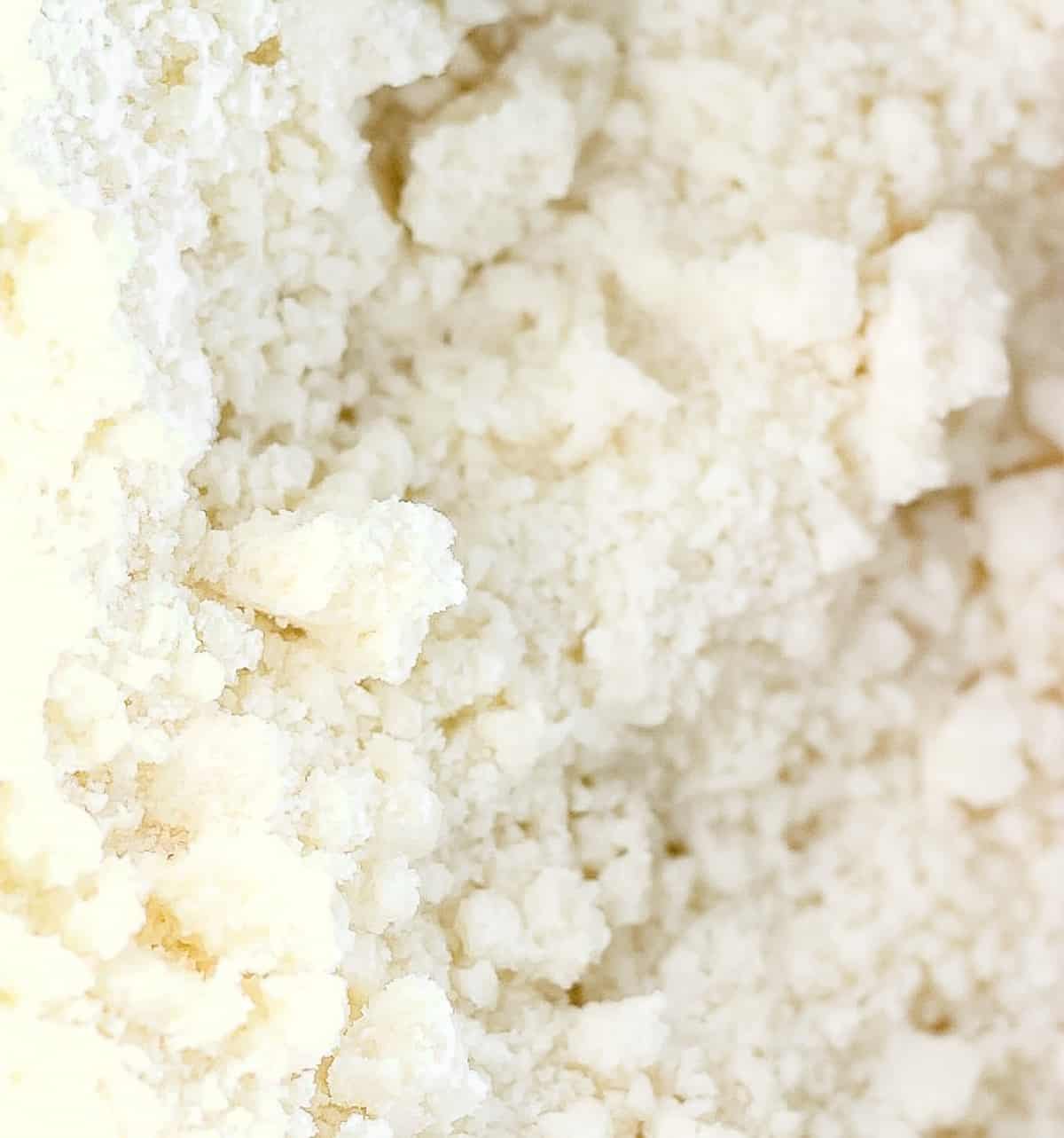
Step 5:
Now pour in about a third of the liquid mixture. Mix that in on low to medium until combined…about 30 seconds to one minute. (Some reverse creaming recipes call for mixing 1-2 minutes at this stage, but be careful about mixing longer than a minute as mixing for too long will cause a dense, rubbery cake.)
Pour the last of the liquid mixture and mix again until well combined. Don’t overmix the batter at this point. Stop mixing once everything is well incorporated.
Use a rubber spatula and scrape the sides of the bowl. Mix again for only about 10 to 15 seconds though.
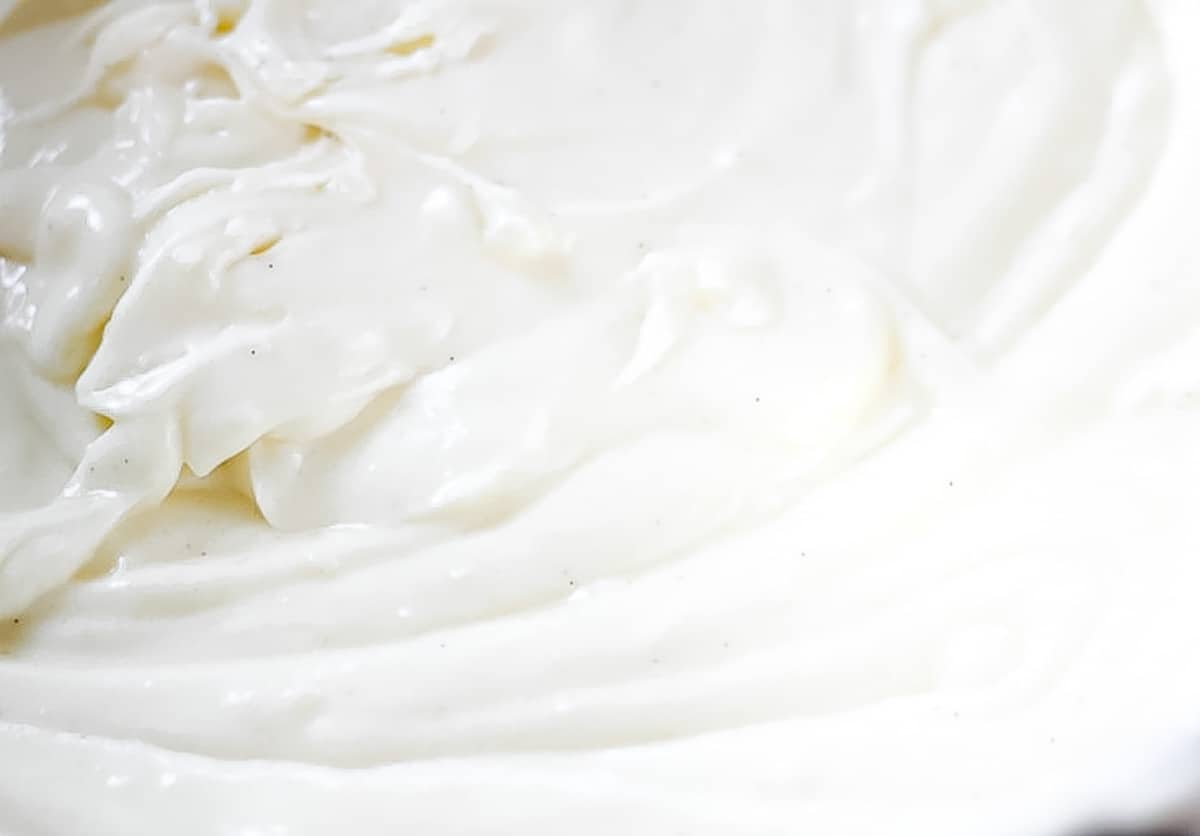
Step 6:
Pour the cake batter into the prepared pans.
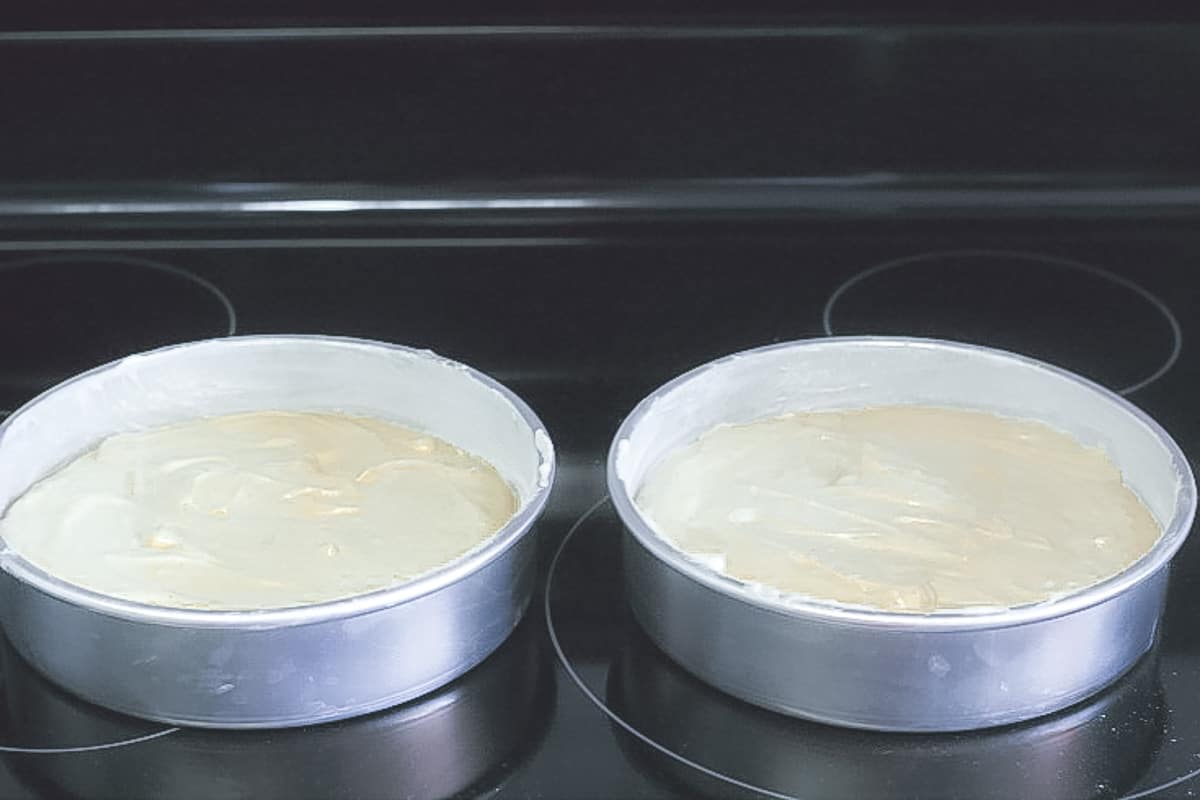
Slide the cakes into the oven and make sure to turn the temperature down to 325 degrees F (unless you’re making these as cupcakes, in which case you’ll want to read the notes below).
Bake the cake layers at 325 degrees F for approximately 40-45 minutes.
The cakes are done when a toothpick inserted into the center of each cake layer comes out with either a few moist crumbs on it or clean, but now raw batter.
You don’t have to wait until the toothpick comes out clean. Just make sure it doesn’t have raw batter on it.
Step 7:
Set the cake layers on wire racks and let them cool for about ten minutes. After they’ve settled for ten minutes, turn the cakes out of the pans and onto the racks.
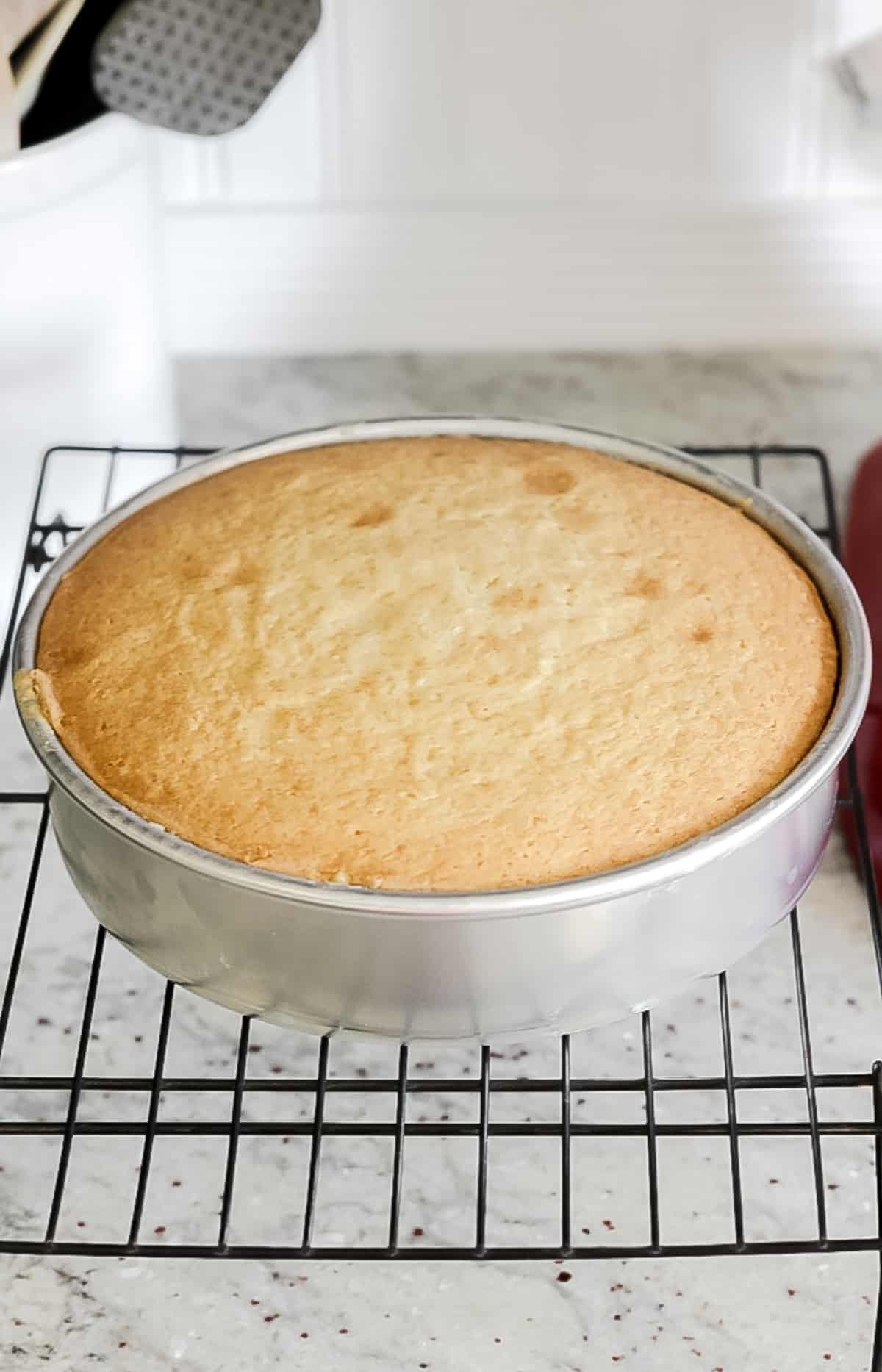
Let them cool out of the pans completely before adding buttercream frosting or freezing the layers.
See my post on how to freeze cake layers and cupcakes here: How to Freeze Cake & Cupcakes
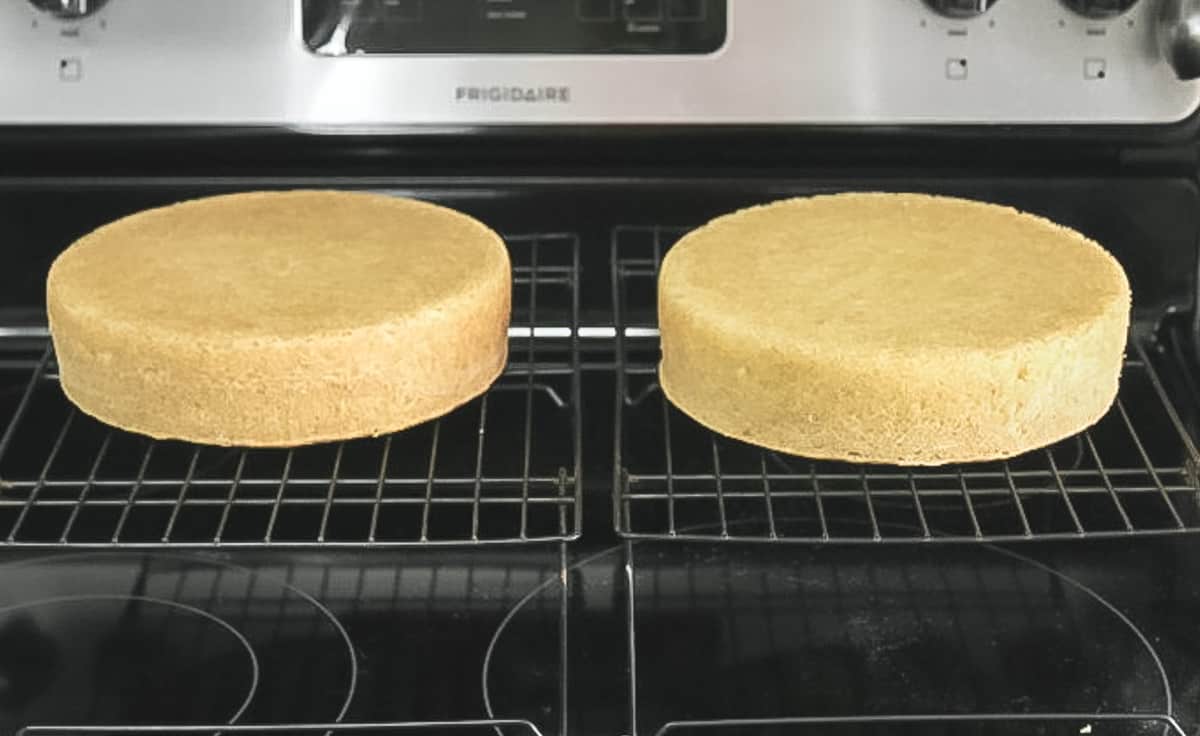
Step 8:
Once the layers are cooled, set one layer on a cake plate or cake platter and add buttercream to the top.
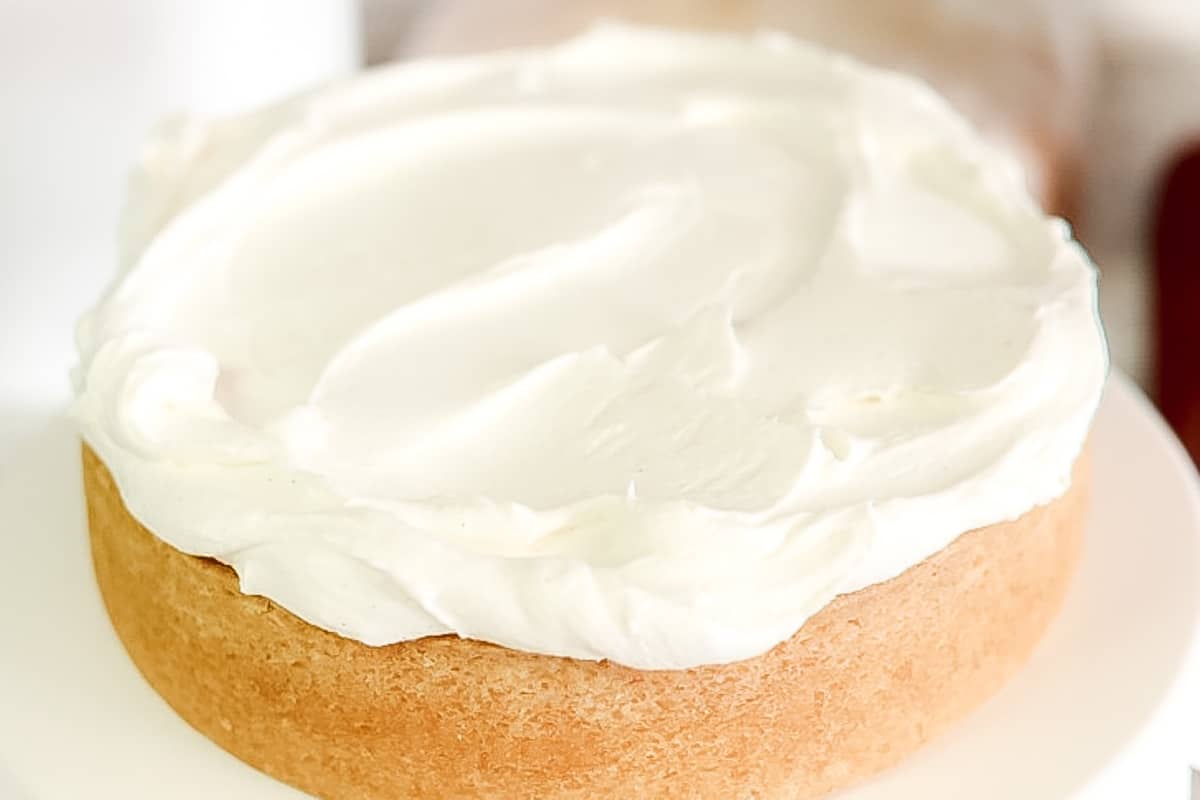
Next, add the second layer and cover the entire cake with buttercream.
You can find my buttercream recipe here: Vanilla Bean Buttercream
Tips & FAQs:
A white cake is usually whiter in color and could use vegetable shortening instead of butter to help get a lighter color cake. The vanilla is also isn’t usually as strong in a white cake as it would be in a vanilla cake.
A vanilla cake usually includes vanilla extract and a vanilla bean cake usually includes vanilla bean paste. Vanilla bean cake usually has a stronger vanilla flavor.
Vanilla bean paste is thicker and uses actual vanilla seeds. Using vanilla bean paste in cakes really pumps up the vanilla flavor.
Here’s a good article from Nielsen-Massey on when to use vanilla bean paste or vanilla extract: When to use Vanilla Bean Paste and Vanilla Extract
You can sometimes get it at craft stores that sell cake decorating supplies, but I generally order mine from Amazon.
Here are some options:
LorAnn Organic Madagascar Vanilla Bean Paste
Native Vanilla Bean Paste
Heilala Vanilla Bean Paste for Baking
Nielsen-Massey Pure Vanilla Bean Paste
Taylor & Colledge Organic Vanilla Bean Paste
Yes you sure can. I think using a good vanilla bean emulsion or paste really pumps up the flavor and can set your cake apart from the rest, but a real vanilla extract will work as well.
Cake flour is different than all-purpose flour and they can’t be substituted for each other in equal amounts. Cake flour will give your cake a more tender texture, so it’s best to use that in this recipe if you can get it.
If you can’t get cake flour, you’ll have to substitute it with all-purpose flour, but you’ll need to make these changes: For every cup of cake flour called for in the recipe, use one cup of all-purpose flour instead and remove two tablespoons of it, then replace that with two tablespoons of cornstarch.
Be careful not to pack the flour down into the measuring cup when you measure it out. That can add too much flour to the batter and cause the cake to be dense and dry. Just spoon the flour into the measuring cup and level it off.
Unsalted butter works best because you can estimate the proper amount of salt that will be added plus salted butter has a different water content than unsalted.
However, if you’re unable to get unsalted butter, you can use salted in the cake and the buttercream, but omit the additional salt that each recipe calls for.
Sour cream is best in this recipe as it helps make a very moist cake and gives a little flavor. If you don’t have access to it, you can use plain yogurt, but use the full-fat yogurt instead of the low-fat or fat-free type.
No, you don’t have to use it, but it’s really a very small amount and it just gives a hint of added flavor. Personally, I think it adds that extra secret ingredient that people just love and it doesn’t actually taste like almonds.
To see an even deeper discussion on why I really like a touch of it in this cake, check out the ingredient section closer to the top of this post.
The mixing method for this cake is called the reverse creaming method because instead of creaming the butter with the sugar, you’ll add the butter, in chunks, to the dry mixture which will coat it.
This method helps produce a softer cake and helps reduce the chance of over-mixing which can over-develop the gluten.
This cake is done baking when a toothpick inserted into the center of each layer comes out with a few moist crumbs on it or clean, but no raw batter.
This cake can be made ahead of time and frozen if desired. Let the baked cake cool completely, then wrap in plastic wrap and foil and place in the freezer for up to a month.
To thaw, place the wrapped cake on the counter at room temperature and let thaw completely, then remove the wrapping. Once defrosted, add the glaze.
This cake can be stored covered at room temperature for several days as long as it’s not covered or filled with a perishable frosting.
To prolong freshness, the cake can then be covered and stored in the refrigerator for a few additional days.
Most cakes are best served close to room temperature, especially when made with butter like this one. If the cake is cold, set it out to come closer to room temperature for about 20-30 minutes before serving.
You can also pop a slice in the microwave to warm up a bit.
Yes, but with a few changes. Fill 2 cupcake pans (24 cupcakes) with cupcake liners and fill with batter about ⅔ of the way full. Bake at 350 degrees F (do not turn the temperature down) and bake for about 15-25 minutes depending on the size of your oven. Start checking for doneness at around 12 minutes just to be sure.
You may have a bit of cake batter left over, but you can chill that batter and make the remaining cupcakes when the others have baked.
Yes, this cake works well for stacking as long as you use proper supports as you would stacking any cake.
As an Amazon Associate, I earn from qualifying purchases.
Supplies used for this recipe:
- Magic Line 8-inch round cake pans or Wilton 8-inch round cake pans
- Whisks
- Silicone spatula
- Mixing bowls
- Stand mixer or electric hand-mixer
- Cooling racks
- Vanilla bean paste options: LorAnn Organic Madagascar Vanilla Bean Paste, Native Vanilla Bean Paste, Heilala Vanilla Bean Paste for Baking, Nielsen-Massey Pure Vanilla Bean Paste, Taylor & Colledge Organic Vanilla Bean Paste, Almond emulsion
- Almond baking emulsion
Video:
Note About Recipe Measurements: I write recipes using volume (cups) measurements because here in the U.S., this is what people are more familiar with and I don’t want anyone to feel intimidated when baking. For metric/weight measurements, click the ‘metric’ button under the ingredients in the recipe card below. The weights are converted by a program, not me, and it’s just a best guess. I can’t guarantee that weighing the ingredients will produce the exact same results, since I test recipes using volume measurements.
Recipe
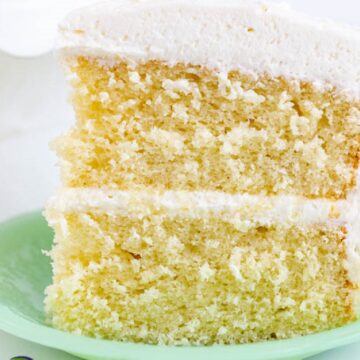
Favorite Vanilla Bean Cake
Ingredients
- 3 cups cake flour (not all-purpose flour, see FAQs in the post for substitutions)
- 2 cups granulated sugar
- 1 ½ teaspoon baking powder
- ½ teaspoon baking soda
- 1 teaspoon salt
- 1 cup unsalted butter, only slightly cooler than room temperature (2 sticks)
- 1 cup sour cream
- ½ cup whole milk
- 1 tablespoon vegetable oil
- 1 tablespoon vanilla bean paste (or vanilla extract)
- ½ teaspoon almond emulsion (optional)
- 3 large eggs
- Vanilla Bean Buttercream (recipe link in the notes section)
Instructions
- Preheat the oven to 350 degrees F. (You will turn the oven temperature down to 325 degrees F once you put the cakes in the oven.)
- Grease and flour two 8" round cake pans. (If making cupcakes, read notes below)
- Combine the flour, sugar, baking powder, baking soda and salt in a large mixing bowl and whisk well. Set aside.
- In another bowl, combine the sour cream, milk, oil, vanilla bean paste, almond extract and eggs. Mix well with a whisk and set aside.
- Cut the almost room-temperature butter into chunks. Turn the mixer on low and slowly add the butter, a bit at a time, to the dry ingredients. Once all the butter has been added, mix on medium to medium-high until all the flour is coated with the butter and the mixture is crumbly. It should have a sand-like texture. If the butter is too warm or if it's mixed for too long, it will form a paste and this will not produce a good cake texture.
- Pour about a third of the liquid mixture. into the dry mixture and mix on low to medium until well combined…about 30 seconds to one minute. (Some reverse creaming recipes call for mixing 1-2 minutes at this stage, but be careful about mixing longer than a minute as mixing for too long will cause a dense cake.)
- Pour the last of the liquid mixture into the dry mixture and mix again until well combined. Don't overmix the batter at this point. Stop mixing once everything is well incorporated, usually no more than about 20-30 seconds.
- Use a silicone spatula to scrape down the sides and bottom of the bowl. Mix again for only about 10 to 15 seconds.
- Pour the cake batter into the prepared pans.
- Slide the cake pans into the oven and turn the oven temp down to 325 degrees F (unless you're making these as cupcakes, in which case you'll want to read the notes below).
- Bake at 325 degrees F for approximately 40-45 minutes. The cakes are done when a toothpick inserted into the center of each layer comes out with a few moist crumbs on it or clean, but no raw batter.
- Set on wire racks to cool for ten minutes, then turn the cakes out onto the racks and let them cool out of the pans completely before adding buttercream frosting.
Notes
Nutrition
How to Share
I’d love for you to share this recipe link or tag it, but please do not share screenshots or copy/paste the recipe to social media as the content and photographs are copyright protected and we (bloggers) work really hard on our content. Sharing the link, tagging us on socials and pinning it is super appreciated though!

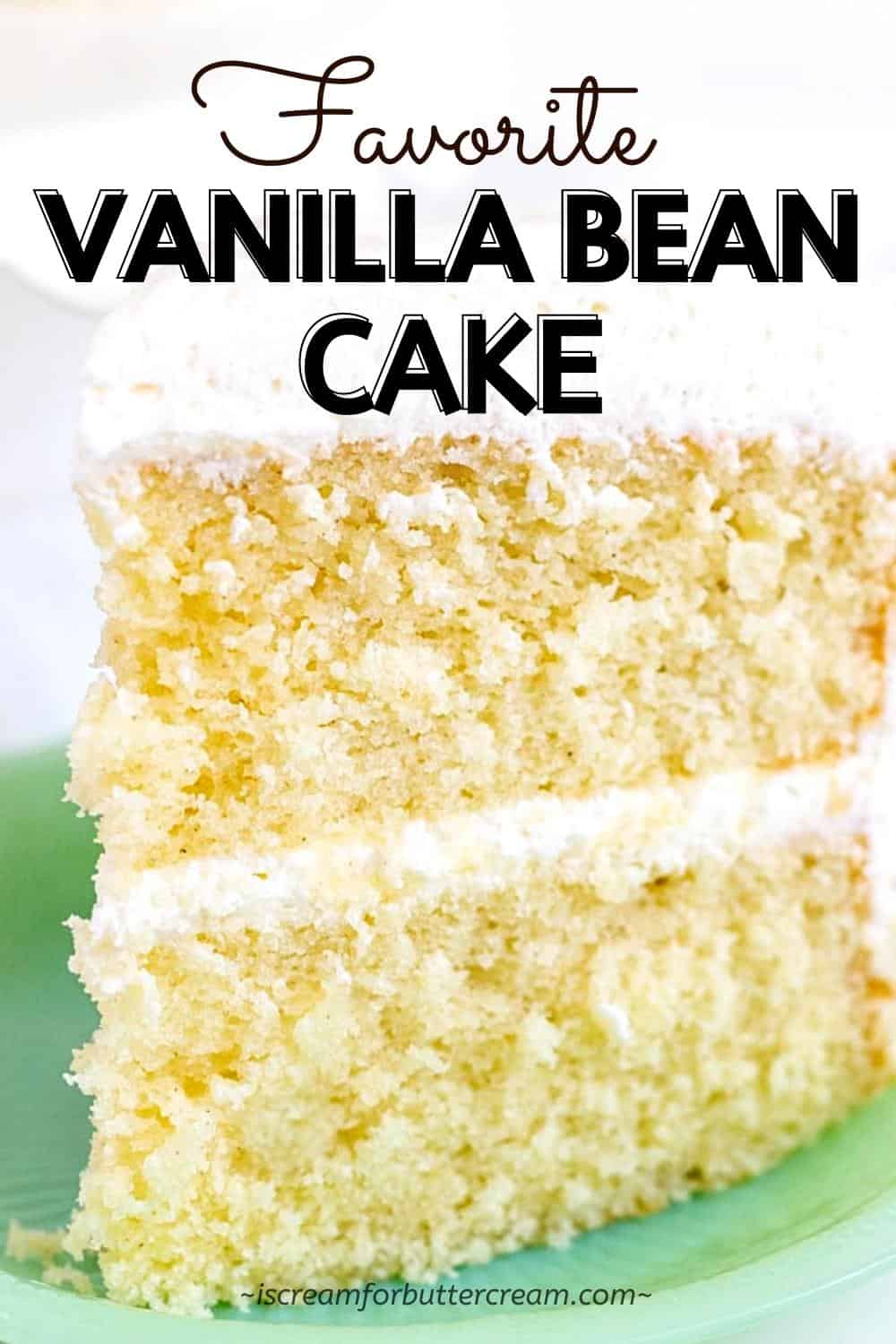
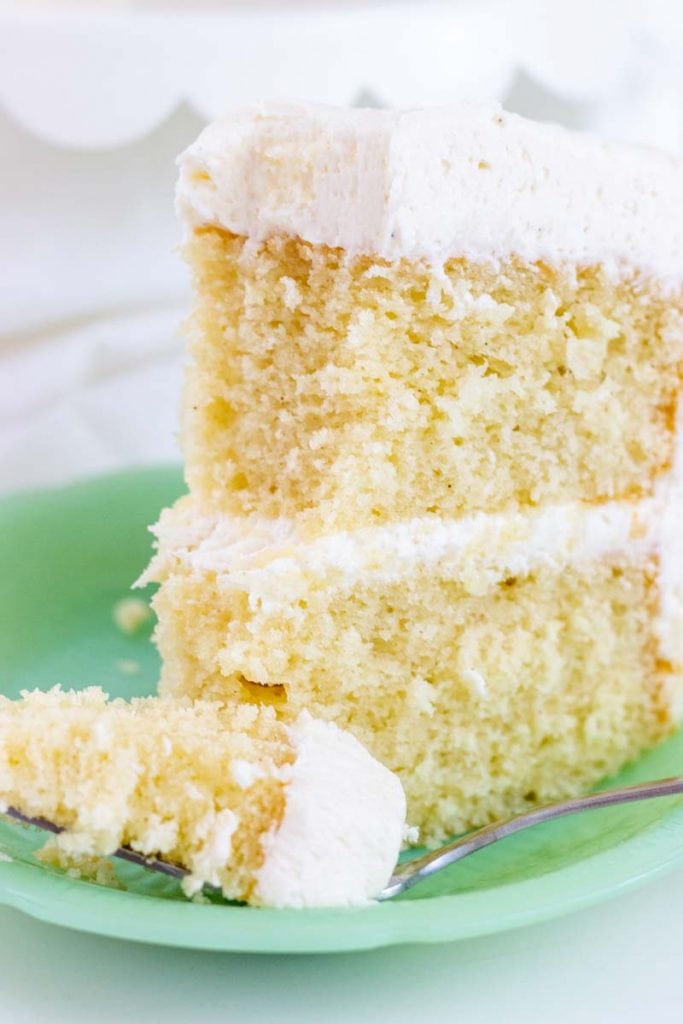
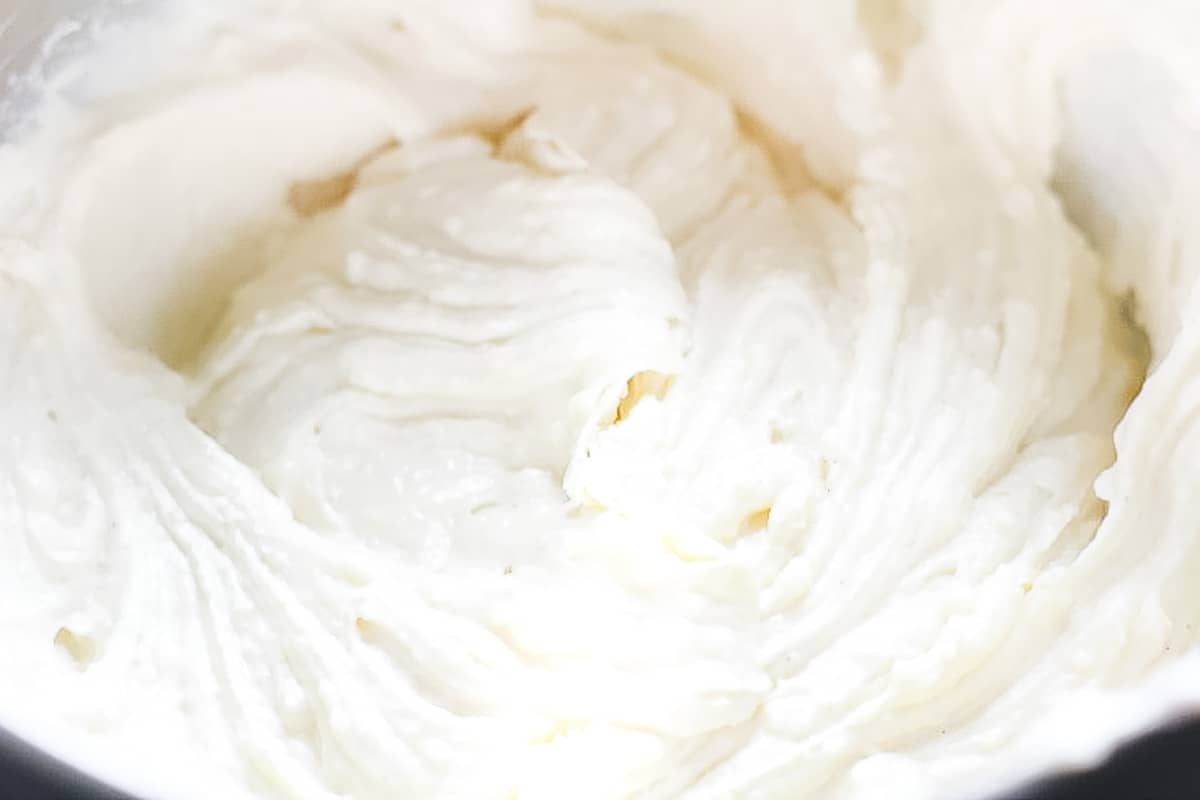
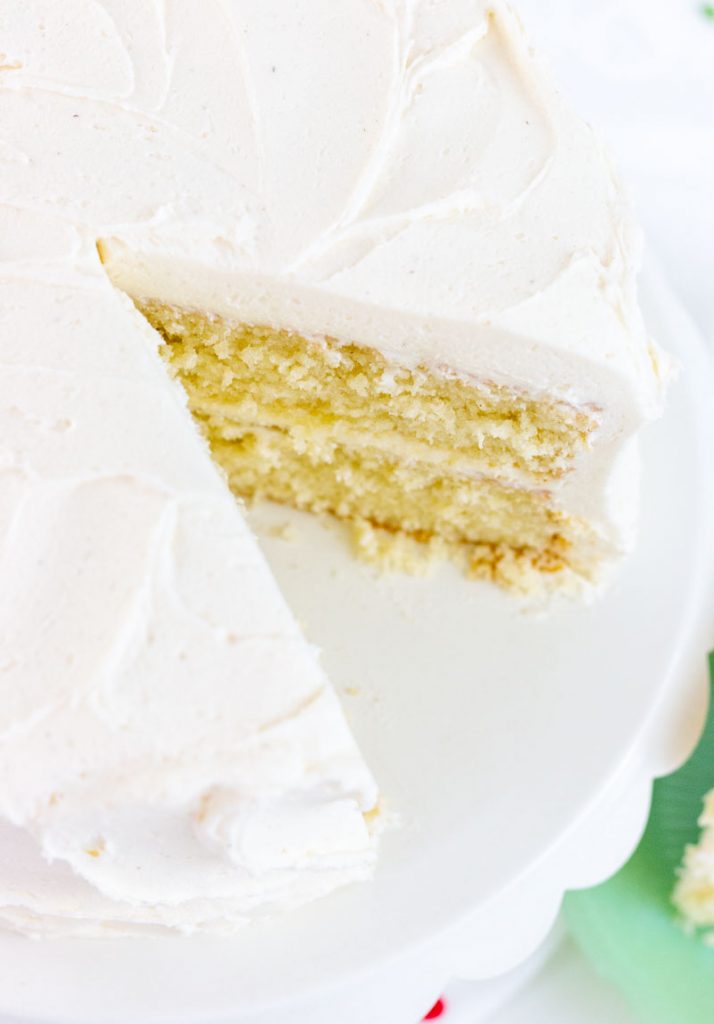

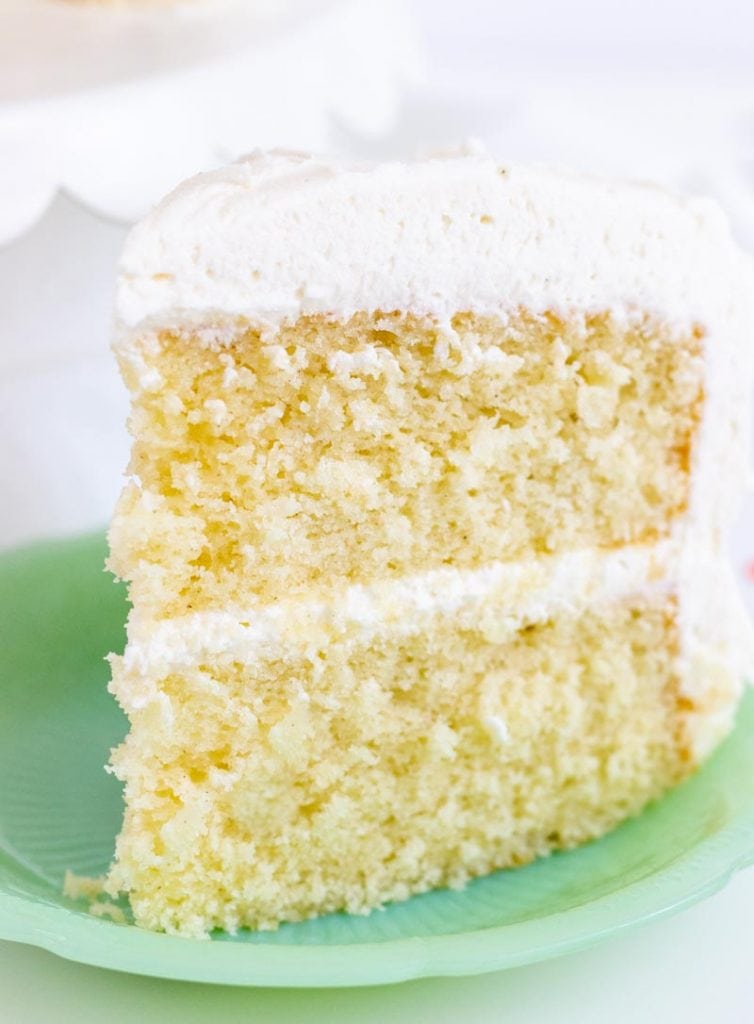
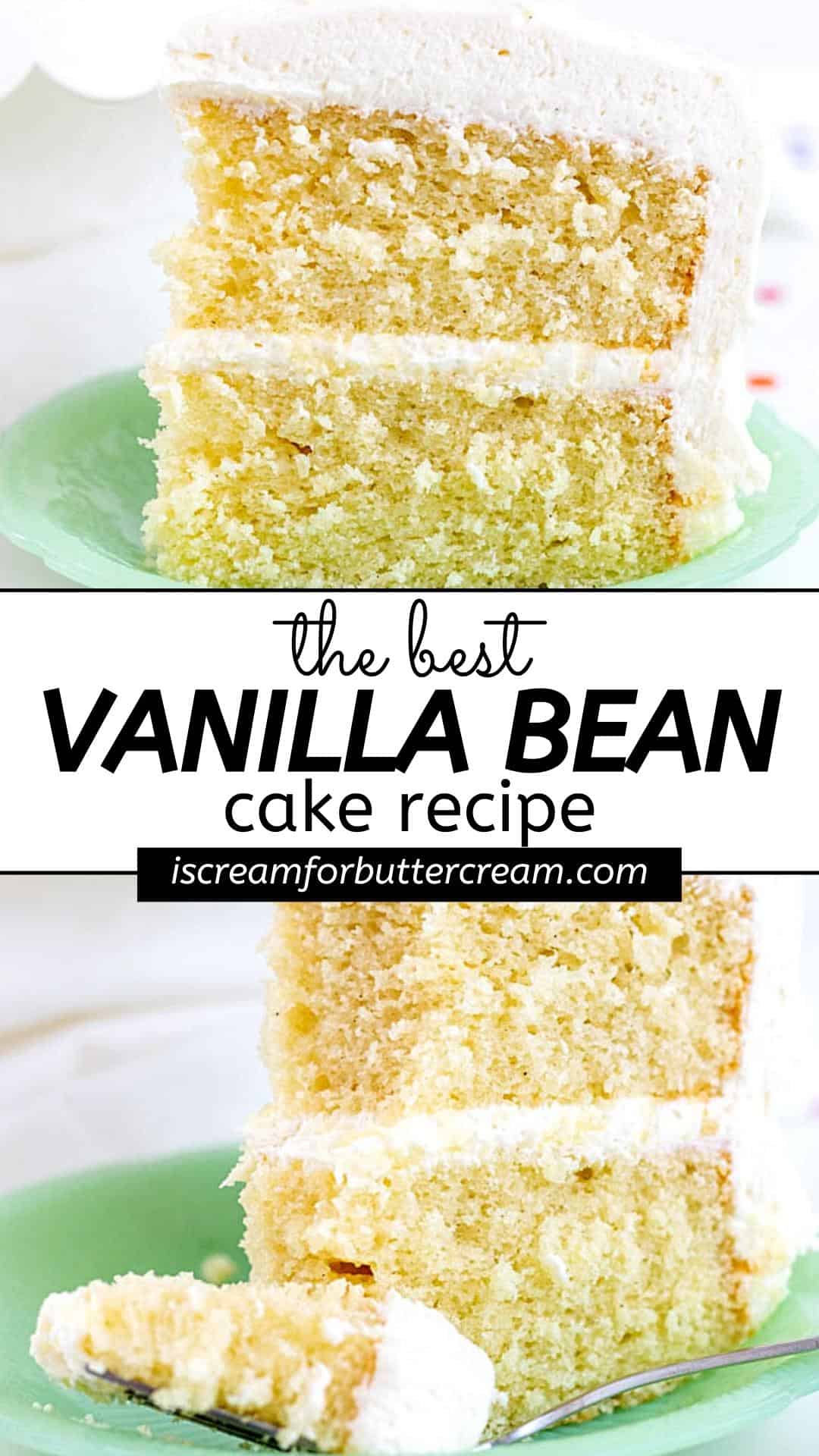
Marilyn
Is the vanilla bean buttercream icing a crusting icing? And can I put fondant on top of it?🇨🇦
Kara
Marilyn, it will crust a little but not like a shortening-based frosting. I think it actually works better under fondant than a crusting buttercream though because it’s actually made of butter and it can be chilled and firmed up and that helps when applying the fondant. I wouldn’t add a thick layer though. Personally, I use ganache under fondant as it works much better for me, but I do know decorators who really prefer buttercream.
Michelle
hi.. can this be made into a sheet cake.. what would be the temp and cook time.. making a cake for my son’s birthday
Kara
I think you’re making an 11×14 sheet cake, correct? It should bake just fine in an 11×14 pan. I’ve done it before myself. You could even use a heating core in the middle to help it bake more evenly. That helps sometimes when baking in sheet pans.
The next question though is how deep is the sheet pan? If it’s still 2 inches deep, like a regular cake pan, then you’ll still bake it at the same temp and probably around the same time, although it might take a bit longer since the pan is bigger. You’ll also want to mix up about a batch and a half of the recipe (instead of just one recipe batch), since the pan is bigger than what the recipe calls for. You might have a little batter left over, once you fill the pan 2/3 of the way full, but you can just bake a few cupcakes if you do.
Now, all this changes if the pan is one of those thin sheet cake pans like a baking sheet. If you’re baking in a pan that is shallow, you’ll need to bake it for less time as it won’t be as thick and will bake through much sooner. I have not tested this recipe out with a thin pan, so I don’t know exactly how long, but I’d set the timer for about 15-20 minutes, then keep a close eye on it from there.
Hope this helps and best of luck on your son’s cake!
Simi
Ok… first of all, THIS CAKE RECIPE IS GLORIOUSLY AMAZING. You’ve basically changed my life at this point lol. It’s going to be my go-to recipe now. I’ve been looking for a moist cake recipe that isn’t dense and this one exceeded my expectations by far. I do have a question! Have you tried/would you recommend trying to adapt this recipe to make a chocolate version or do you think it wouldn’t work well?
Kara
Oh what a wonderful review! This just made my day and I’m so glad you love this one! Thank you so much for the five stars. 🙂 And you ask a good question…I have not fully adapted this one to make a chocolate cake, but I do have a really good chocolate cake recipe on the website that gets great reviews if you’d like to check it out. Here’s the link to that one: https://iscreamforbuttercream.com/chocolate-butter-cake/ I think that one is just as good as this cake but in a chocolate way. 😉 lol
Simi
I will be trying it later today, thank you so so much! So excited to check out more of your recipes 🙂
Jane C
I made this cake today and it did not disappoint!! It is so moist and tender with a great buttery- yellow cake flavor!! It is my go to for vanilla cake. I have tried many recipes, but this one is the best. I’m a real believer in the reverse creaming method!! Thank you for working so hard to perfect all these great recipes 🙌🏼🙌🏼
Kara
Wonderful Jane! So glad you loved it and thanks so much for the great review! 🙂
Michelle
I made this cake the other day and I followed the directions I watched your video it was a very delicious cake but mine came out a little heavy and I don’t know what I did wrong??? I don’t know I don’t think I overmixed it but do you have any suggestions of what I might’ve done. Thank you !
Kara
Hi Michelle, hmmm I’m not totally sure what happened. Like you said, the biggest reason cakes might come out heavy or dense is if it’s mixed too long. The other thing I’ll say is that this cake won’t be as fluffy as a box cake mix, since it’s a scratch cake. Scratch cakes are sometimes just a bit heavier or denser than a box cakes. Having said that, this cake should not be very dense though. If it was very heavy, something did go wrong. Another thing besides overmixing that I’ve found with cakes that call for the reverse creaming method (like this one) is that if the butter is too warm, then when it’s mixed with the dry mixture, it doesn’t end up sand-like, but way more clumpy…like if you kept going, it would make a rough paste. I hope that makes sense.
Anyway, I’ve done that myself when the butter was just a little too warm and the cake came out dense and heavier. Now when I make it, I’m careful to make sure that the butter is slightly cooler than room temp. I know that sounds so picky…and I really wish scratch cakes weren’t so pickly. If you try it again, make sure the butter hasn’t set out too long before you use it and try and mix it a little less or on a lower speed and see if that helps. Let me know how it goes.
Kristen Chang
Mine came out a bit heavy and dense as well, followed to a tee- professional baker.
Kara
So sorry, Kristen. Since you’re a professional baker, there’s probably not much I can suggest that you don’t already know. The only reason I can think of that it would be heavy would be that it was mixed a little too long, or that maybe the butter was a little warm when mixed with the flour during the reverse creaming method. Sometimes I’ve had my butter just a bit too warm and it formed more of a paste than a sand=like texture and the cake came out a little more dense. That could have been an issue, but I don’t know other than those two things. I’ve just not had it come out heavy and dense for me other except for when the butter was just a little too warm. Sorry again!
Kristen Chang
How is this different from the yellow cake? I know the yellow has more yolks, but is this as moist as the yellow cake?
I made it and when I was getting the butter and dry mixture to resemble sand, it was pretty uniform with just a few small pieces of butter. Is that the correct way or should look? I baked it and the top and sides looked more brown than yours so I trimmed it off. I don’t think I overbaked it but the edges seemed crumbly. Did I do something wrong?
Kara
Hi Kristen, I can’t be sure if you did anything wrong, it sounded like you got the dry mixture and butter correct though. It doesn’t have to be perfect though, it just needs to resemble sand without large clumps in it. Just make sure once you add the liquid ingredients that you don’t mix too long as that will mess up a cake’s texture. I’m not sure why the outside was crumbly though. It could be that your oven runs a little hot? Did you make sure and turn the oven down to 325 degrees F when you popped it in? Sometimes I forget to do that and it can overbake the outside a little if it’s not turned down. I do have a video for making it though and it’ll show what the batter should look like etc. Here’s the link for that: https://youtu.be/jNbh0W__bhI
As far as the yellow cake goes…it is different than the vanilla one. It’s made with buttermilk instead of sour cream and uses two whole eggs plus two egg yolks instead of three whole eggs. There are other minor differences to the yellow cake as well. It does have a slightly different taste to me. It seems a little richer (not sweeter), just a little richer. It’s also moist as well. Feel free to try that if you like as well. 🙂
Jeana
I baked this cake a few days ago for a trial run as I am preparing to bake my granddaughter’s 1st birthday cake. I just had to be sure it was the perfect cake for her special day. I followed the recipe closely and it was absolutely 💯 delicious!!! Moist, tender and so flavorful! I topped it with the vanilla bean buttercream, which was delicious also, but honestly I could just eat the cake by itself!!! Daughter-in-law and granddaughter approved!!! Will be repeating the process today for the special cake.
Question… I ended up with a significant crust, that looked different from the picture here. could that have been due to me opting to line pans with parchment paper? just curious. the crust was actually nice for adding crumb coat icing. and once it absorbed the moisture from icing it was perfect texture.
thanks for sharing this recipe!!!
Kara
Yay! I’m so glad this one worked for you! So for the crust, I’m not sure what happened. I don’t think I’ve gotten a crust like that before on this cake. Maybe I don’t because I use the shortening and flour coating on the pan and it soaks into it? I’m just not sure. Another thing I thought of was…did you make sure to turn the oven temp down after you added the pans? If the oven is a little too hot, that might have caused it.
Thanks again for the great review!
Kristen Chang
That crust happened to my cake too but it was fine. I thought maybe I baked it too long but I’m glad it wasn’t just me!
Kara
Oh interesting…hmmm. It may be because of the amount of sugar, since this cake calls for a good amount of it. I wouldn’t lower the amount though as that’s what makes the cake sweet and moist, but maybe that could contribute to the crust. Also check the oven with an oven thermometer and make sure it’s at 325. It may run just a bit hotter which could cause a crust as well.
Kristina
I’m excited to make this cake for my daughters 6th Birthday!
A couple quick questions.. any tips for adding food colouring? I’m going to use gels as opposed to liquids. Can you use 2% milk or must it be whole milk? Also, can you use full fat plain greek yogurt in place of sour cream?
Kara
Hi Kristina. Happy early birthday to your daughter! So, yes…your idea of using gel food coloring is a good one as they’re much more concentrated than the liquid kind. Try to add it to the liquid ingredients when you mix those up (at the beginning of the batter making process), that way you’re less likely to over mix the cake batter by adding it at the end of the process. If you need to add a little more once all the batter is mixed up, you still can, but you have to try your best not to mix too long or the cake will come out rubber and tough.
Also, it’s perfectly fine to use 2% milk. Whole milk has more fat in it, so it’s better for cakes, but personally I’ve made this cake a bunch of times with 2% and it worked just fine. Also, you can use the full fat plain Greek yogurt. I think sour cream works the best, but if you prefer using yogurt, or have trouble getting access to sour cream, then yogurt works fine. I hope this helps!
Adeline
hey! i’m a new baker and i have an order for 50 cakesicles. everyone i see uses box mixes but i like to know what ingredients are in the things i bake so i try to make everything myself. do you think this recipe would be good to use? and do you have a frosting recommendation? thanks!
Kara
Hi Adeline, so are you wanting to make cakesicles like cake pops…using crumbled baked cake? If so, you can probably use almost any cake recipe to do that. That’s basically the same way you’d make cake pops and I’ve used this recipe to do that a bunch of times. This one is one of my favorite vanilla cake recipes, but I also have a similar version that I love too…you can find that one here: https://iscreamforbuttercream.com/moist-vanilla-cake-strawberry-filling/
Obviously you don’t need to add the strawberry filling…the vanilla cake is just really good by itself.
For the frosting, you can use probably any type of American buttercream. I have a recipe here: https://iscreamforbuttercream.com/vanillabeanbuttercreamrecipe/
You probably won’t use all of it, so you could make a half batch. Just add a tablespoon of buttercream to the cake crumbs at a time and mix together. Check the consistency to make sure it all sticks together well. If more is needed, then add more. Most people accidently add too much to start with, so just go with a heaping tablespoon or two at first, then you can add more if it needs it.
I hope this helps.
CarLy
I love you cakes. Could this be easily made in a 9 x13pan?
Kara
Yes, you can bake this in a 13×9 inch pan.
AJ
Have you or anyone tried any egg substitutes for this recipe? I would love to know how it turned out! Thank you!
Kara
AJ, I haven’t tried using egg substitutes with this. I was hoping someone else might chime in if they had tried that out though.
Marilyn Brown
This cake is outstanding so moist so delicious vanilla flavor, this cake will be my go to.
Kara
Yay! I’m so glad you loved it and thanks so much for the great review!
Kimberly
Going to make this later today!! Can you do a crumb coat first with this buttercream or should I use a store bought buttercream for a crumb coat then this on top? I need it to shape well.
Kara
I don’t always crumb coat cakes, but if I do, I generally use homemade buttercream. I find it to be more stable than canned buttercream.
Heidi
I will be making this cake or your white cake for my granddaughters birthday. Do you have a good chocolate frosting as that was her request. I love your whipped cream, cream cheese frosting that I use on your delicious carrot cake. Something like that but in chocolate would be amazing. Thank you 😊
Kara
Hi Heidi! I have a couple options for you:
Whipped Chocolate Buttercream: https://iscreamforbuttercream.com/whipped-chocolate-buttercream-frosting/
Chocolate Cream Cheese Buttercream: https://iscreamforbuttercream.com/chocolate-cream-cheese-buttercream/
Double Chocolate Buttercream (this one is closer to a class buttercream and not as light and fluffy as the whipped recipe above): https://iscreamforbuttercream.com/double-chocolate-buttercream-recipe/
I hope these help!
Kylie Butler
Can this cake be made with gluten free flour instead?
Kara
I think I remember a few people trying it with gluten free flour and said that it turned out well. I haven’t personally tried it, so I’m not sure how it would turn out. If you try it, I’d try using the 1 to 1 gluten flour and see how it goes.
Lydia
Hi Kara!
First off, I absolutely love this cake recipe! This is pretty much what I exclusively use as the base cake for almost all of my white cake variations. Quick question. I want to use this as a base for a blueberry lemon cake. I’m going to use blueberry in the filling, and add lemon zest to the cake. Do you think it would work if I swap the almond emulsion with lemon extract? I’m worried if I only use zest, it won’t have enough lemon flavor.
Kara
Hi Lydia, so I actually just tested out the lemon version of this yesterday! It turned out great, but I’m still in the testing phase. I’ll drop the ingredients below if you’d like to try it out. It’s very similar, but uses lemon zest, lemon juice and an additional 2 tablespoons of lemon pudding mix which is optional. Here’s the ingredients (you can try the reverse creaming method for this like the vanilla cake, or you can try the regular creaming method. The regular creaming method might give you a slightly fluffier cake). Just note, I’m still in the testing phase so it may not be perfected just yet:
2 3/4 all-purpose flour
2 teaspoon baking powder
½ teaspoon baking soda
1/2 teaspoon salt
2 tablespoons instant lemon pudding mix small box (If you use the entire box, sometimes it will make the cake sink in the middle.)
2 cups sugar
1 cup unsalted butter, room temperature (two sticks)
3 eggs, close to room temperature
1 cup sour cream, close to room temperature
1 teaspoon vanilla extract
1 teaspoon lemon extract
1/3 cup lemon juice
1 tablespoon oil
2 tablespoons lemon zest (from about two lemons)
yellow food coloring (optional)
Christina
Hi Kara 🙂
I’ve made this recipe multiple times for cake and cupcakes and absolutely love it! I was recently asked to make 100 cupcakes for an event and am wondering if I could get away with doubling the batch. I can only bake 24 at a time so the rest of the batter would have to sit for the baking time of the first batch. Do you think it’s a bad idea?
Kara
Hi Christina, so glad you love this recipe! So, honestly you can probably double it, but for absolute best results, I’d just make one batch at a time. I’ve doubled it before to make cake layers and it was fine, but it always seems less dense when I only make one batch at a time. I’m not sure why it does that, but maybe it just ends up a little over mixed when doubling it. I’ve had this happen to me with other cake recipes as well. The texture just seems better when it’s made one batch at a time. Either way, if you do try doubling it, I don’t think it would hurt the batter to sit (covered and in the fridge) while you bake the other cupcakes. It does have a little bit of baking soda in it, so I wouldn’t let it sit for long though or the baking soda will lose its effectiveness. Hope this helps!
Christina
Thanks so much for replying. I think I’ll just stick with one batch at a time then. I wont take a chance since its for a grad thing for a bunch of people I dont know lol. But at some point for a less important event I’m going to try doubling it just to see how it turns out!
Kara
I agree…I usually go with the safest option when doing something for an important event.